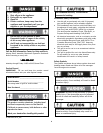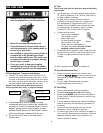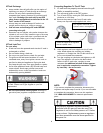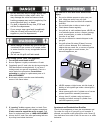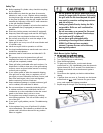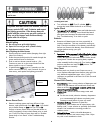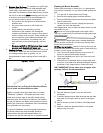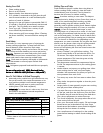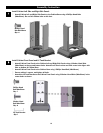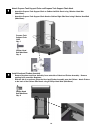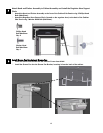Special offers from our partners!

Find Replacement BBQ Parts for 20,308 Models. Repair your BBQ today.
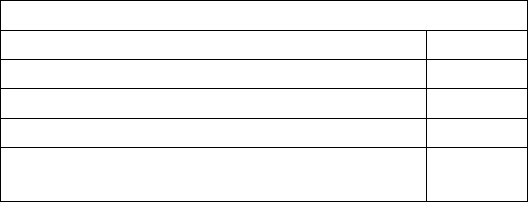
10
Storing Your Grill
Clean cooking grates.
Store in a dry location.
Remove battery from electronic ignition.
If LP cylinder is connected to the grill, then the grill
must be stored outdoors in a well ventilated space
and out of reach of children.
Storage of a gas grill indoors is permissible ONLY if
LP cylinder is turned off, disconnected, and removed
from grill. The LP cylinder must remain outdoors.
Cover your grill. Choose from a variety of grill
covers offered by manufacturers.
When removing grill from storage, follow “Cleaning
the Burner Assembly” instructions before starting the
grill.
Food Safety
Food safety is a very important part of enjoying the
outdoor cooking experience. To keep food safe from
harmful bacteria, follow these four basic steps:
Clean: Wash hands, utensils, and surfaces with hot soapy
water before and after handling raw meat and poultry.
Separate: Separate raw meats and poultry from ready-
to-eat foods to avoid cross contamination. Use a clean
platter and utensils when removing cooked foods.
Cook: Cook meat and poultry thoroughly to kill bacteria.
Use a thermometer to ensure proper internal food
temperatures.
Chill: Refrigerate prepared foods and leftovers promptly.
For more information call: USDA Meat and Poultry
Hotline at 1-800-535-4555 (10:00 am – 4:00 pm EST).
How To Tell If Meat Is Grilled Thoroughly
Meat and poultry cooked on a grill often browns very
fast on the outside. Use a meat thermometer to be
sure food has reached a safe internal temperature.
NEVER partially grill meat or poultry and finish
cooking later. Cook food completely.
WARNING: To ensure that it is safe to eat, food must
be cooked to the minimum internal temperatures
listed in the table below.
USDA* Safe Minimum Internal Temperatures
Beef, Veal, Lamb & Pork: Whole Cuts**
145° F
Fish
145° F
Beef, Veal, Lamb & Pork: Ground
160° F
Egg Dishes
160° F
Turkey, Chicken & Duck: Whole, Pieces, &
Ground
165° F
* United States Department of Agriculture
**Allow meat to rest three minutes before carving or
consuming.
Grilling Tips and Tricks
Food cooked on the grill is either done using direct or
indirect cooking. Direct cooking is when the food is
cooked directly over lit burners. Food is placed in-
between the lit burners for indirect cooking.
Direct: Use direct cooking to sear meats. This helps to
keep food moist by locking in juices. Some food, such as
steak, is first seared using direct cooking, and then
finished cooking using the indirect method. This is
generally used for quicker cooking foods. Remain vigilant
when grilling using this method, as it’s easy to overcook.
Indirect: Is used for foods that take longer to cook,
including large cuts of meat such as roasts. It’s also used
for cooking more delicate food that can dry out quickly
such as fish and poultry, for fattier foods to reduce flare-
ups, and when grilling using a roasting pan or aluminum
foil. Turn burners to medium or low depending on the
temperature you want to maintain. Do not place the food
directly over any burner when using this grilling method.
You can also grill indirectly by turning one or more
burners off and placing the food over those burners that
are not being used.
Always “Preheat” your grill before cooking. Turn
burner control knobs to Hi and close the lid for 5 to
10 minutes. Then adjust the burner controls to the
proper temperature. This heats the grates to help
prevent food from sticking.
The thermometer measures the temperature high on
the lid. The temperature down by the cooking grates
is warmer.
Mother Nature can impact your grilling times. Allow
more cooking time for cold, wind, and higher
altitudes. We recommend you place your grill in an
area protected from much wind.
Trim away any excess fat from meat to reduce flare-
ups.
Keep similar size portions together so that they cook
more evenly.
Larger pieces of meat generally require more cooking
time per pound than smaller pieces.
If a major flare-up or too many flare-ups occur, turn
off the gas, and move the food away from the flare-
up. Restart the grill once the flare-up has died down.
Use a lower temperature to reduce flare-ups.
Turn foods infrequently. Use tongs rather than a fork
when turning food on the grill.
Know your sauce and when to apply. Oil and vinegar
based sauces can be brushed on any time. Sugar
based sauces like barbecue sauce should be applied
during the last few minutes of cooking.
Use a small amount of cooking oil on the cooking
grates before heating to reduce foods sticking on the
grates.



